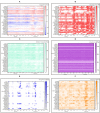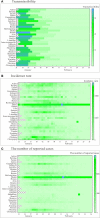Assessing the Impacts of Meteorological Factors on COVID-19 Pandemic Using Generalized Estimating Equations
- PMID: 35844849
- PMCID: PMC9284004
- DOI: 10.3389/fpubh.2022.920312
Assessing the Impacts of Meteorological Factors on COVID-19 Pandemic Using Generalized Estimating Equations
Abstract
Background: Meteorological factors have been proven to affect pathogens; both the transmission routes and other intermediate. Many studies have worked on assessing how those meteorological factors would influence the transmissibility of COVID-19. In this study, we used generalized estimating equations to evaluate the impact of meteorological factors on Coronavirus disease 2019 (COVID-19) by using three outcome variables, which are transmissibility, incidence rate, and the number of reported cases.
Methods: In this study, the data on the daily number of new cases and deaths of COVID-19 in 30 provinces and cities nationwide were obtained from the provincial and municipal health committees, while the data from 682 conventional weather stations in the selected provinces and cities were obtained from the website of the China Meteorological Administration. We built a Susceptible-Exposed-Symptomatic-Asymptomatic-Recovered/Removed (SEIAR) model to fit the data, then we calculated the transmissibility of COVID-19 using an indicator of the effective reproduction number (Reff ). To quantify the different impacts of meteorological factors on several outcome variables including transmissibility, incidence rate, and the number of reported cases of COVID-19, we collected panel data and used generalized estimating equations. We also explored whether there is a lag effect and the different times of meteorological factors on the three outcome variables.
Results: Precipitation and wind speed had a negative effect on transmissibility, incidence rate, and the number of reported cases, while humidity had a positive effect on them. The higher the temperature, the lower the transmissibility. The temperature had a lag effect on the incidence rate, while the remaining five meteorological factors had immediate and lag effects on the incidence rate and the number of reported cases.
Conclusion: Meteorological factors had similar effects on incidence rate and number of reported cases, but different effects on transmissibility. Temperature, relative humidity, precipitation, sunshine hours, and wind speed had immediate and lag effects on transmissibility, but with different lag times. An increase in temperature may first cause a decrease in virus transmissibility and then lead to a decrease in incidence rate. Also, the mechanism of the role of meteorological factors in the process of transmissibility to incidence rate needs to be further explored.
Keywords: COVID-19; generalized estimating equations; lagged effect; meteorological factors; transmissibility.
Copyright © 2022 Lin, Rui, Xie, Zhan, Chen, Zhao, Zhu, Li, Deng, Yu, Li, Ke, Zeng, Su, Chiang and Chen.
Conflict of interest statement
The authors declare that the research was conducted in the absence of any commercial or financial relationships that could be construed as a potential conflict of interest.
Figures



Similar articles
-
Meteorological factors and tick density affect the dynamics of SFTS in jiangsu province, China.PLoS Negl Trop Dis. 2022 May 9;16(5):e0010432. doi: 10.1371/journal.pntd.0010432. eCollection 2022 May. PLoS Negl Trop Dis. 2022. PMID: 35533208 Free PMC article.
-
Interaction between meteorological parameters and COVID-19: an ecological study on 406 authorities of the UK.Environ Sci Pollut Res Int. 2021 Dec;28(47):67082-67097. doi: 10.1007/s11356-021-15279-2. Epub 2021 Jul 9. Environ Sci Pollut Res Int. 2021. PMID: 34244943 Free PMC article.
-
Region-specific air pollutants and meteorological parameters influence COVID-19: A study from mainland China.Ecotoxicol Environ Saf. 2020 Nov;204:111035. doi: 10.1016/j.ecoenv.2020.111035. Epub 2020 Aug 5. Ecotoxicol Environ Saf. 2020. PMID: 32768746 Free PMC article.
-
Association of Short-Term Exposure to Meteorological Factors and Risk of Hand, Foot, and Mouth Disease: A Systematic Review and Meta-Analysis.Int J Environ Res Public Health. 2020 Oct 30;17(21):8017. doi: 10.3390/ijerph17218017. Int J Environ Res Public Health. 2020. PMID: 33143315 Free PMC article.
-
Associations between meteorological factors and COVID-19: a global scoping review.Front Public Health. 2024 Jul 18;12:1183706. doi: 10.3389/fpubh.2024.1183706. eCollection 2024. Front Public Health. 2024. PMID: 39091528 Free PMC article.
Cited by
-
Association between provincial sunshine duration and mortality rates in China: Panel data study.Heliyon. 2023 Apr 30;9(5):e15862. doi: 10.1016/j.heliyon.2023.e15862. eCollection 2023 May. Heliyon. 2023. PMID: 37215780 Free PMC article.
-
A large-scale machine learning study of sociodemographic factors contributing to COVID-19 severity.Front Big Data. 2023 Mar 24;6:1038283. doi: 10.3389/fdata.2023.1038283. eCollection 2023. Front Big Data. 2023. PMID: 37034433 Free PMC article.
-
Assessing eco-geographic influences on COVID-19 transmission: a global analysis.Sci Rep. 2024 May 22;14(1):11728. doi: 10.1038/s41598-024-62300-y. Sci Rep. 2024. PMID: 38777817 Free PMC article.
References
-
- Wang M, Jiang A, Gong L, Luo L, Li H. Temperature significant change COVID-19 transmission in 429 cities. Sci Total Environ. [Preprint]. (2020). 10.1101/2020.02.22.20025791 - DOI
Publication types
MeSH terms
LinkOut - more resources
Full Text Sources
Medical

